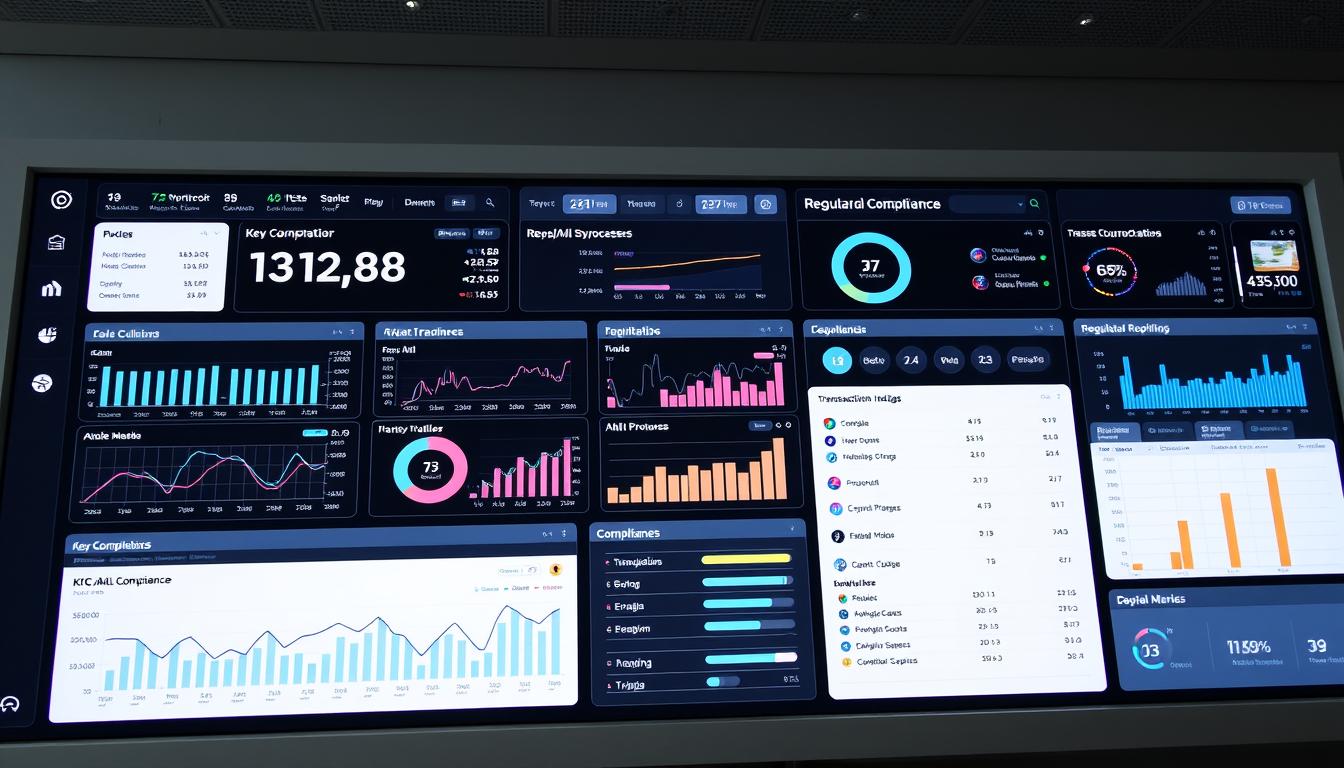Now Reading: AI Cryptocurrency Regulatory Compliance Tools for US Firms
- 01
AI Cryptocurrency Regulatory Compliance Tools for US Firms
AI Cryptocurrency Regulatory Compliance Tools for US Firms

For American businesses in the digital asset space, the regulatory landscape is shifting rapidly. Authorities like the SEC and FinCEN are increasing their scrutiny, making robust oversight a top priority.
Meeting these demands is no longer just about avoiding fines. It is a strategic necessity for building trust and ensuring long-term success.
Modern solutions have evolved far beyond simple monitoring. They now leverage advanced technology to provide real-time risk detection and cross-chain intelligence.
This guide explores how these sophisticated platforms help organizations navigate complex requirements. We will cover core features and future trends to help you make an informed decision.
Key Takeaways
- Regulatory pressure on digital asset businesses in the United States is intensifying significantly.
- Effective oversight is now a strategic necessity, not just a legal requirement.
- Advanced solutions offer real-time risk detection and behavioral analysis.
- These platforms are essential for building trust with partners and investors.
- Traditional methods often fall short in the dynamic crypto ecosystem.
- This guide provides a comprehensive overview for selecting the right platform.
Introduction and Buyer’s Guide Overview
Organizations handling digital transactions face mounting pressure to implement robust monitoring systems. This comprehensive roadmap helps US companies build or enhance their oversight infrastructure using advanced technology.
Crypto compliance encompasses laws and best practices governing digital asset operations. Its purpose is preventing illegal activities while fostering transparency and trust in the ecosystem.
| Stakeholder Type | Primary Needs | Key Challenges | Solution Focus |
|---|---|---|---|
| Crypto-Native Companies | Real-time monitoring | Evolving regulations | Scalable systems |
| Traditional Financial Institutions | Integration with existing frameworks | Cross-chain visibility | Risk assessment tools |
| Corporations Adopting Digital Assets | Transaction transparency | Reporting requirements | Audit-ready documentation |
| Regulatory Bodies | Standardized reporting | Market surveillance | Data consistency |

This guide systematically explores the evolution of requirements, current landscape, core functionalities, and implementation strategies. Understanding both regulations and technological capabilities is essential for success.
Designed for professionals and executives, this resource helps make informed decisions about selecting platforms that align with specific operational needs and risk profiles.
The Evolution of Crypto AML and Regulatory Compliance
Financial crime prevention entered a new era with the emergence of decentralized digital asset ecosystems. Traditional anti-money laundering frameworks faced unprecedented challenges when confronted with blockchain’s unique characteristics.
From Traditional Finance to Digital Assets
Legacy AML systems were built for fiat currency moving through centralized banks. They tracked transactions between known entities with established identities.
Digital finance introduced pseudonymous addresses and irreversible transfers across decentralized networks. This created new vulnerabilities that criminals quickly exploited.

Money laundering in the crypto space often involves hundreds of rapid transfers across multiple wallets and blockchains. These complex patterns are specifically designed to obscure the origin of funds.
Increasing Complexity in Regulatory Requirements
Multi-hop cross-chain laundering has become the standard approach for sophisticated criminals. They use intermediary wallets and cross-chain bridges to complicate detection.
Sanctions evasion tactics now involve seemingly legitimate payment providers and OTC broker services. These professional enablers make traditional monitoring approaches less effective.
Regulators now demand proactive controls rather than reactive responses. Clear documentation of risk-based decisions is essential for audit readiness and examination success.
The Regulatory Landscape for US Crypto Firms
The United States has established a multi-agency approach to supervising digital currency activities. This framework involves several key authorities with distinct responsibilities and expectations.

US Regulatory Bodies and Their Expectations
Multiple federal agencies oversee different aspects of digital asset operations. The SEC focuses on securities offerings, while FinCEN handles anti-money laundering requirements.
These regulators expect real-time wallet screening and transaction monitoring. They require documentation of risk management decisions and suspicious activity reporting.
Different jurisdictions within the US may have varying requirements. This creates complexity for businesses operating across multiple states.
Adapting to Shifting Enforcement Priorities
Enforcement focus areas change regularly as new risks emerge. Companies must maintain flexible frameworks that can adapt without complete overhauls.
Failure to meet expectations carries serious consequences. These include significant fines, license revocation, and mandatory independent oversight.
Understanding this landscape is essential for selecting appropriate systems. Different agencies require specific capabilities and reporting formats.
AI Cryptocurrency Regulatory Compliance Tools
Sophisticated technology platforms now offer specialized solutions for managing financial oversight in the blockchain space. These enterprise-grade systems represent a distinct category designed specifically for digital asset operations.
Unlike traditional rule-based approaches, modern platforms leverage machine learning and behavioral analysis. They identify complex patterns across multiple chains without constant manual updates.

These comprehensive tools integrate multiple functions into unified systems. They handle wallet screening, transaction monitoring, risk assessment, and regulatory reporting.
The architecture processes vast blockchain data in real-time. Analytical models generate risk scores and create actionable alerts for investigation teams.
Effective compliance tools balance automation with clear reasoning. They provide documentation that professionals can defend to examiners.
When evaluating these platforms, companies should consider several criteria:
- Accuracy in risk detection across various crypto assets
- Coverage of multiple blockchain networks and protocols
- Integration capabilities with existing operational frameworks
- Alignment with current examination expectations
- Vendor reliability in this rapidly evolving market
For crypto firms operating in the US, selecting the right tools is critical. The right choice supports both legal requirements and business growth objectives.
Core Functionalities of AI-Powered Compliance Solutions
Advanced detection methods have transformed how organizations approach transaction security. These systems provide essential capabilities for identifying suspicious activities across digital asset networks.
Modern platforms combine multiple analytical approaches to deliver comprehensive protection. They address the unique challenges of blockchain-based financial operations.
Transaction Monitoring and Risk Scoring
Effective transaction monitoring tracks digital asset flows in real-time across multiple chains. Unlike traditional systems, these solutions interpret complex on-chain patterns.
Many platforms rely on exposure-based risk scoring that flags addresses after illicit interactions occur. However, behavioral detection identifies suspicious patterns before attribution is available.
Sophisticated risk scoring combines multiple factors for comprehensive assessments. This includes transaction velocity, structuring attempts, and interaction with high-risk services.
Know Your Customer (KYC) Integration
KYC procedures verify user identities before granting financial service access. They collect identification documents and validate credentials to prevent anonymity-driven crimes.
Modern systems integrate know your customer data with ongoing transaction monitoring. This creates unified customer risk profiles for more accurate assessments.
The combination provides financial institutions with the visibility needed for effective anti-money laundering efforts. These interconnected capabilities form a robust defense against illicit activities.
| Risk Detection Method | Primary Focus | Detection Timing | Effectiveness |
|---|---|---|---|
| Exposure-Based Scoring | Past interactions with known entities | After funds have moved | Limited for rapid transfers |
| Behavioral Pattern Analysis | Suspicious transaction patterns | Real-time detection | Proactive risk prevention |
| Multi-Factor Assessment | Combined risk indicators | Continuous monitoring | Comprehensive protection |
Behavioral Risk Detection and On-Chain Analytics
Modern risk detection moves beyond simple exposure tracking to analyze actual transaction behaviors across blockchain networks. This approach examines how wallets operate rather than just checking their interaction history.
Behavioral analysis identifies suspicious patterns that traditional systems might overlook. These include structuring, where large transactions break into smaller amounts to avoid detection thresholds.
Obfuscation patterns represent another key behavioral indicator. Criminals use mixers and layering techniques to disguise fund origins across multiple transfers.
Transaction velocity analysis flags abnormal activity speeds that suggest laundering attempts. Rapid movements between addresses often indicate efforts to obscure money trails.
These behavioral signals enable proactive risk identification before attribution becomes possible. They help teams detect emerging threats that exposure-only systems would miss.
Sophisticated platforms establish baseline behaviors for different wallet types. They then flag deviations that indicate potential fraud even without known bad actor exposure.
Combining behavioral detection with exposure scoring creates comprehensive protection. This dual approach catches both established threats and new criminal methodologies.
The result is a shift from reactive responses to preventive controls. Teams can intercept suspicious activity in real-time rather than responding after funds have moved.
Leveraging Cross-Chain Tracing to Uncover Hidden Risks
Cross-chain money laundering tactics have evolved to exploit gaps in fragmented compliance systems. Criminals now move assets across multiple networks in minutes using bridges and swaps.
This creates significant blind spots for teams conducting financial monitoring. Without proper cross-chain intelligence, illicit funds can disappear across blockchain boundaries.
Real-Time Tracking Across Multiple Blockchains
The bZx incident from November 2021 demonstrates this challenge. Attackers drained $55 million and used four cross-chain bridges to move funds to Ethereum.
Many platforms claim comprehensive coverage but offer only partial visibility. Analysts must manually reconstruct complex transaction paths across different explorers.
| Tracing Capability | Basic Platforms | Advanced Solutions | Impact on Detection |
|---|---|---|---|
| Cross-Chain Coverage | Limited to major chains | 50+ blockchains, 640+ bridges | Comprehensive vs. fragmented |
| Real-Time Tracking | Delayed updates | Instant asset following | Proactive vs. reactive |
| Visualization Tools | Separate explorers needed | Unified graph view | Clear vs. confusing paths |
| Automation Level | Manual reconstruction | Automatic tracing | Efficient vs. labor-intensive |
Effective platforms provide automatic tracing across dozens of networks. They identify bridge transactions and present complex paths in understandable formats.
This capability is essential for detecting modern laundering patterns. Teams gain complete visibility rather than partial snapshots of asset movements.
Managing False Positives with Advanced AML Tools
Alert fatigue represents a critical vulnerability in financial oversight programs. When systems generate excessive false alarms, investigation teams become overwhelmed and miss genuine threats.
Traditional rule-based approaches create significant operational burdens. They rely on simple heuristics that cannot distinguish between legitimate complex transactions and actual suspicious activity.
Modern tools employ sophisticated models that understand context and recognize legitimate business patterns. These systems apply nuanced risk assessment rules that dramatically reduce unnecessary alerts.
Effective false positive management requires practical techniques that balance sensitivity with specificity:
- Tunable risk thresholds that reflect specific business models
- Customizable rule sets that evolve with transaction patterns
- Feedback loops that improve accuracy over time
- Workflow tools that help teams efficiently disposition alerts
This continuous refinement process ensures compliance professionals can focus limited resources on genuine threats. The right balance must adapt as criminal tactics evolve.
Advanced aml processes transform false positive management from an operational challenge to a strategic advantage. They enable teams to maintain effective oversight without being buried in noise.
Integrating AI with Established Regulatory Frameworks
Successfully navigating the complex web of global financial oversight demands seamless integration between technology and legal frameworks. These systems must work within existing structures rather than operating independently.
The oversight landscape for digital assets changes constantly across different regions. Some jurisdictions encourage innovation through regulatory sandboxes and clear guidelines.
Aligning with US Banking and Financial Regulations
Platforms must support multiple US oversight requirements simultaneously. These include the Bank Secrecy Act, FinCEN guidance, and SEC regulations.
State-level money transmission laws add another layer of complexity. Effective systems maintain alignment with specific jurisdictional requirements without separate installations.
Bridging Global Compliance Standards
Multinational operations face a patchwork of sometimes conflicting rules across borders. Systems must adapt to multiple frameworks including MiCA and FATF’s Travel Rule.
Configurable controls allow adjustments for specific jurisdictional requirements. This approach combines technological capabilities with expert interpretation of evolving standards.
Successful programs use advanced technology as enablers of regulatory alignment. They bridge the gap between innovation and established oversight expectations.
Data Quality, Explainable Risk Scoring, and Auditability
The foundation of any effective oversight program rests on three critical pillars: reliable data, transparent methodologies, and comprehensive audit trails. These elements work together to create defensible decision-making frameworks that withstand examination scrutiny.
High-quality underlying data forms the bedrock of sound risk assessment. Leading platforms maintain dedicated analyst teams for each threat category. These specialists collect ground-truth evidence on illicit operations across various networks.
Explainable risk scoring overcomes the “black box” problem that plagues many systems. Compliance teams must articulate precisely how decisions were reached. Transparent engines provide full visibility into what drove each assessment.
Comprehensive audits require detailed documentation of every decision point. This includes timestamped records and source attribution for each piece of data. The ability to reconstruct historical contexts is essential for regulatory defensibility.
| Aspect | Traditional Approach | Modern Solution | Regulatory Impact |
|---|---|---|---|
| Data Quality | Limited threat coverage | Dedicated analyst teams per category | Higher confidence in assessments |
| Risk Scoring | Opaque algorithms | Fully transparent methodologies | Defensible during examinations |
| Audit Trail | Basic decision records | Comprehensive documentation with source attribution | Clear evidence of due diligence |
| Transaction Monitoring | Rule-based alerts | Context-aware detection with explanation | Reduced false positives |
Regulators increasingly expect firms to demonstrate robust processes backed by reliable information. The combination of quality data, clear scoring, and thorough audits creates a framework that meets evolving standards.
Enhancing Transparency in Transaction Monitoring and Investigations
Clear visibility into financial activities forms the bedrock of trust between digital asset firms and their stakeholders. Modern systems serve a dual purpose: they act as the first line of defense and the central engine for complex case analysis.
This approach supports teams through the entire investigation lifecycle. It begins with real-time detection of potential exposure to suspicious activity.
Sophisticated intelligence then surfaces contextual data for rapid triage. This allows analysts to quickly assess if a case needs escalation.
The tracing phase provides crucial transparency by mapping fund flows across wallets and services. Visual formats make complex transaction paths easy to understand and document.
| Investigation Phase | Core Function | Impact on Transparency |
|---|---|---|
| Detection & Triage | Identifies and assesses risk | Provides immediate visibility into potential issues |
| Tracing & Attribution | Maps funds and connects to entities | Creates a clear, defensible narrative of activity |
| Escalation & Reporting | Generates auditable case files | Ensures documentation meets strict standards |
Attribution connects wallet activity to known entities using blockchain intelligence. Systems then generate auditable case files with visual charts for reporting.
Ongoing monitoring continues screening for new risks. This entire process, documented with full transparency, builds institutional knowledge and improves operations over time.
Navigating Decentralized Finance and Exchange Challenges
Decentralized finance presents a unique set of oversight challenges that traditional financial systems never encountered. These platforms operate without central authorities, creating both opportunities and complications for companies operating in this space.
By 2025, regulatory attention has firmly shifted toward DeFi’s rapid expansion. The industry responds through two primary approaches: self-regulatory initiatives and direct collaboration with oversight bodies.
Smart Contract Audits and Safe Deployment
Smart contracts form the backbone of many blockchain projects, automating agreements through code. Thorough audits have become essential for identifying vulnerabilities before deployment.
These comprehensive reviews examine code integrity and potential security gaps. They help organizations mitigate risks associated with automated financial operations.
Specific DeFi complications include absent KYC requirements on many platforms. This creates difficulty identifying responsible parties when issues arise.
Jurisdictional uncertainties represent another significant hurdle. Funds moving through DeFi protocols can cross multiple legal jurisdictions simultaneously.
Effective solutions must assess protocol-level risks and monitor user interactions. They flag high-risk activities like using DeFi services for fund obfuscation.
Navigating these challenges requires specialized capabilities beyond traditional monitoring. Organizations need tools that analyze smart contracts and trace complex DeFi transactions.
Cybersecurity, Data Privacy, and Compliance in Digital Assets
Protecting sensitive customer information while meeting oversight requirements represents a critical balancing act for digital finance companies. These three areas must work together rather than as separate initiatives.
Blockchain’s transparency creates unique privacy concerns. Once exposed, sensitive information cannot easily be removed from immutable records.
Digital asset platforms remain prime targets for hacking and information theft. Significant financial and reputational losses affect both companies and their customers.
Building Robust Data Protection Measures
Regulators now expect advanced protection measures. These include encryption, zero-trust frameworks, and privacy-enhancing technologies.
Specific technical controls include secure key management and access controls. Organizational measures involve data minimization principles and incident response capabilities.
Compliance with regional privacy laws like GDPR must balance with monitoring requirements. This creates complex demands that compliance systems must navigate effectively.
Security and privacy are essential components of comprehensive programs. They protect customer information while demonstrating responsible data stewardship to oversight bodies.
Building a Comprehensive Compliance Strategy for US Firms
Successful financial oversight programs begin with strong leadership commitment and clear accountability structures. Executive buy-in ensures adequate resources and establishes compliance as a business priority rather than just a legal requirement.
Organizations must conduct thorough risk assessments specific to their operations. This identifies threats relevant to their customer base and geographic footprint. Tailored programs then address these specific vulnerabilities.
Building an effective framework integrates multiple components. These include technology platforms, policies, training, and monitoring processes. Each element supports the others in creating robust protection.
Vendor selection requires careful evaluation beyond technical features. Companies should assess stability, integration capabilities, and long-term support. This ensures partnerships that grow with evolving needs.
Effective risk management balances protection with operational efficiency. Controls should reduce threats without creating unnecessary customer friction. This maintains both security and positive user experiences.
Compliance professionals understand this work as an ongoing program. It requires regular assessment and adaptation to changing regulations. Continuous improvement based on experience builds stronger frameworks over time.
Future Trends in AI and Crypto Regulatory Compliance
Future-proofing financial oversight requires anticipating both emerging risks and technological solutions. The landscape continues to evolve rapidly as both threats and defenses become more sophisticated.
Emerging Threats in the Digital Asset Space
Criminal networks now leverage advanced technologies to scale their operations. They automate money laundering through complex layering techniques across hundreds of wallets.
Privacy-enhancing tools like mixers and decentralized services create significant challenges for monitoring teams. These methods obscure transaction trails and complicate fund origin tracing.
New blockchain protocols introduce additional vulnerabilities that bad actors quickly exploit. Maintaining visibility remains critical for detecting and preventing financial crime.
Innovative Solutions on the Horizon
Advanced detection models offer promising responses to these evolving risks. Federated learning approaches enable collaboration while preserving data privacy.
Regulators are developing more sophisticated standards including real-time reporting requirements. Cross-jurisdictional frameworks will improve information sharing across borders.
Blockchain-native protocols embed oversight capabilities directly into network operations. This represents a fundamental shift from external monitoring to integrated protection.
The ongoing technological arms race demands continuous investment in capabilities. Organizations adopting advanced systems today will better adapt to tomorrow’s requirements.
Conclusion
Strategic oversight programs now serve as competitive advantages rather than mere regulatory obligations. This guide has demonstrated how comprehensive protection frameworks have become essential infrastructure for organizations in the digital asset space.
The landscape will continue evolving, making adaptability a critical factor. Companies must select solutions that meet current requirements while preparing for future changes.
Effective protection combines multiple layers working together. This includes robust technology, quality data, clear processes, and trained teams. These elements form an integrated system that builds trust and supports growth.
Viewing oversight as a core competency enables firms to operate confidently. It attracts institutional investment and enables partnerships with traditional financial institutions.
Organizations should assess their current capabilities and identify specific gaps. Developing prioritized roadmaps for implementation ensures sustainable operations.
As the industry matures, firms with strong foundations will capitalize on emerging opportunities. Strategic investment in oversight capabilities supports long-term success in this transformative sector.
FAQ
What are the main benefits of using intelligent systems for managing financial risk in the crypto sector?
These platforms significantly enhance an organization’s ability to monitor transactions and identify suspicious patterns. They automate complex processes, reducing manual workload for teams and improving the accuracy of risk scoring. This leads to better protection against fraud and money laundering while meeting strict legal standards.
How do these solutions handle Know Your Customer (KYC) obligations?
Modern systems integrate KYC checks directly into their workflows. They verify customer identities using advanced data analysis, helping institutions ensure they understand who they are dealing with. This integration is vital for meeting anti-money laundering (AML) rules and building a trustworthy customer base.
Can these platforms track activity across different blockchain networks?
A> Yes, a key feature of advanced platforms is cross-chain tracing. They provide real-time tracking capabilities across multiple blockchains like Bitcoin and Ethereum. This gives financial services firms a complete view of transaction flows, uncovering hidden exposures that might be missed when looking at a single network.
How do these tools help reduce false positives in transaction monitoring?
By using sophisticated algorithms, these systems can better distinguish between normal and suspicious behavior. They analyze vast amounts of data to provide more context, which lowers the number of false alerts. This saves compliance professionals valuable time and allows them to focus on genuine threats.
What should a company look for when choosing a compliance platform?
Organizations should prioritize solutions that offer strong data protection, clear audit trails, and alignment with established frameworks like those from US banking regulators. The ability to adapt to shifting enforcement priorities across different jurisdictions is also critical for long-term success.
How do these systems address the unique challenges of Decentralized Finance (DeFi)?
They incorporate specialized features for DeFi, such as smart contract audit capabilities and safe deployment protocols. This helps firms navigate the decentralized landscape by identifying vulnerabilities and ensuring operations meet necessary controls, even on permissionless platforms.












